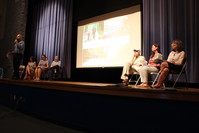


Identifying what priorities local recreational groups would like to see in the St. Johns County trail system, forming a trails advocacy group, and getting feedback from these groups and the general public was the focus in a trails symposium that took place July 13 at Pedro Menendez High School.
Hosted by St. Johns County in conjunction with the St. Johns County Trails Coalition, the symposium was the first in what will be a series of such sessions to discuss both greenways and blueways – public access to the waterways for activities such as boating, canoeing or kayaking – with a goal of updating the St. Johns County Greenway, Blueway and Trails Master Plan, according to St. Johns County Parks and Recreation Director Wil Smith.
The plan to hold public symposia stemmed from a recent county survey in which a staggering 83 percent of the people who responded said that their number one priority for recreation over the next five to 15 years were trails in this county.
“Whether it’s connecting public land to public land, residential to public land, residential to commercial, people wanted to see trails,” Smith said.
Trails not only create recreational activity opportunities, he noted, but also offer an alternate transportation corridor. They can also have a positive economic impact: Smith pointed to bicycle tourism as an example, which he said can garner a huge economic impact when people come to the county to ride bikes, spending millions of dollars that will go back into the local economy.
Smith said the county has already been approached by Bike Florida – a nonprofit bike tourism organization – that would like to bring its event to the fairgrounds next year, creating an opportunity to highlight the trail system in St. Johns County.
“We’ll see people from all over Florida as well as the southeast United States come to St. Johns County and we’ll be able to showcase our trails,” Smith said.
Symposium panel
The symposium panel was comprised of six representatives from varying user-interest groups: Deb Chapin from the Ponte Vedra Greenway Alliance; Herb Hiller of the East Coast Greenway Alliance; Mary Farr from the St. Johns County Horse Council; Southern Off-Road Bicycle Association Jacksonville representative Todd Cejka; St. Johns County Audubon Society President Jean Rolke; and Heather Neville from the Velo Fest Community Initiative, a nonprofit, St. Augustine-based group focused on cycling safety and education. Representatives presented their priorities for a greenway trails system in turn.
Afterwards, attendees broke off into groups to brainstorm and list their priorities coming from the standpoint of a number of represented recreational groups: bicycle, equestrian, hikers and environmental advocates. The groups then presented their top priorities.
The St. Johns County Horse Council’s Farr approached Smith prior to the symposium to ask what they could do to get more equestrian trails in St. Johns County.
Farr touched on what she sees as the six main obstacles to forming a greenway trail system: finances, land acquisition, labor, maintenance, sharing trails and legal and liability.
Her group outlined its objectives, with their number one priority being equestrian trails. The group would also, however, like to see wildlife corridors, land bridges, safe passages in high traffic areas, and proper trail heads.
“… St. Johns County Parks and Recreation staff are creative and work on the cutting edge of the greenways and trails movements,” Farr said. “They are working for our goals, but to get our trails done, county staff needs the sanction and support of the citizens. Let’s work together and get these trails done.”
Audubon Society President Jean Rolke said her group supports the greenway trails initiative because of their concern over climate change and rising sea levels that impacts bird nesting grounds. Non-motorized trails, Rolke said, will lower the carbon footprint brought on by vehicular traffic.
“It will lower it by some,” she said, “not much, but every little bit helps.”
Rolke also highlighted trash management at access points and pet management regarding leash laws for dogs as some of her organization’s concerns for the greenway trails.
Heather Neville of the Velo Fest Community Initiative identified her group’s priorities as interconnectivity of trails, economic centers connectivity and multimodal trails. Neville touched on the timeline of getting a trails system project moving and acknowledged that this will be a long process, but it will be worth it, she said.
As for off-road cyclists, Todd Cejka of SOBA-JAX, said the user group he is representing would like to see an unpaved greenway for its recreation purposes. He stressed, however, the need to keep bike trails and horse trails separate. One of the solutions he suggested for the separation would be double-track trails where single-track trails would remain primarily for biking use.
He would also like to see proper signage and maps for the trail system and interconnectivity of the greenways and trails with multiple trailheads.
One thing that all groups could agree on is the fact that the trails need to be multi-use and the people who will utilize the trails, regardless of their chosen recreational activity, need to co-exist.
Next steps
The information acquired through the symposia will be used to set goals and agendas. Participating groups were asked to look at maps of publically owned county land, a map of the St. Johns County Greenway, Blueway and Trails Master Plan, and development map to see how things can be tied together from a user groups’ perspective.
Their feedback will be helpful to county staff, Smith said, because when projects are identified, they can also identify grants, saving the county money.
St. Johns County, in conjunction with the St. Johns County Trails Coalition, plans to have quarterly blueways and greenways meetings. The next greenway trails symposium is tentatively scheduled for the fall in Nocatee.